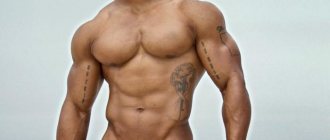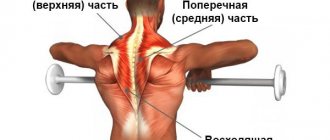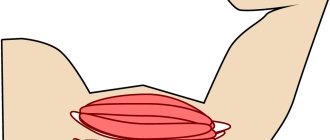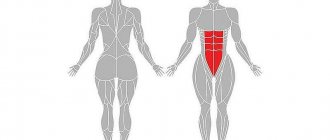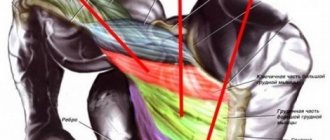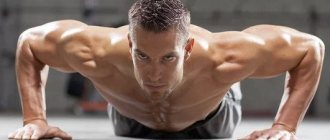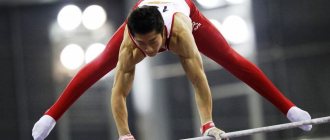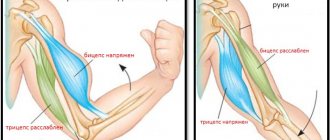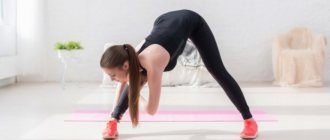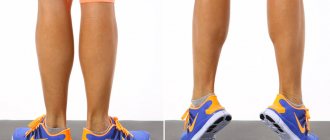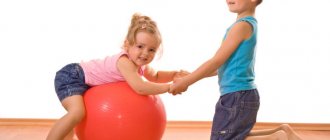Features of the anatomical structure
In order to quickly achieve results, you need to understand how to pump up a trapezoid at home and know the features of its structure. The trapezius muscles are located in the upper back. The fibers are responsible for connecting the latissimus dorsi muscles and neck and visually form a geometric figure, for which they got their name.
The trapezius muscles are divided into three types, each of which constitutes a functionally independent area. The following muscle groups are distinguished:
- the upper ones are responsible for raising the shoulder blades and shoulders, they are the ones that allow you to lift and carry heavy objects;
- lower - perform lowering of the shoulder blades and shoulders;
- middle - allow movement of the scapula towards the spine.
Ideally, at home or in the gym, all three muscle groups should be worked out, and for training to be effective, the program should include a set of exercises that allows you to work in all areas. The main sports equipment for home use are dumbbells, while barbells and parallel bars are more often used in the gym.
The middle muscles are worked at home when performing any type of bent over rows. The lower region responds well to lifting weights overhead when performing various types of bench presses. The top of the trapezoid is loaded with shrugs, of which there are a huge number.
Workout for Beginners
Let's start with athletes who want to strengthen and pump up their back. And rightly so, because, like no other, they form an enviable V-shaped figure.
The first complex for beginner athletes. Therefore, it is worth mentioning the dynamics: all exercises are performed smoothly, both up and down, without jerking or swinging, exhale when going up, inhale when going down. And we don’t jump from the horizontal bar, but stand carefully if the vertebrae and their integrity are important.
So, the first thing is hanging on the bar. An excellent exercise to start your workout, because this way you stretch both the spine and back muscles. By the way, you also greatly strengthen your grip, which will be very useful for you when performing basic training with a barbell, for example. The longer you hang, the better.
To strengthen the lumbar region, we will make a corner on the horizontal bar. There are two options for its execution: with straight legs and with knees bent, pressing them as much as possible to the chest. The first pumps up the abs much better, which is why I recommend it. The second one is quite easy.
Now we move on to regular pull-ups with a medium straight grip. In addition to the shoulders, first of all, it strengthens the back muscles. It must be performed so that at the top point you touch the bar with your chest or chin.
Do this independent exercise every other day, and when you can do at least 3 sets of 12 times each, move on to the next level.
Barbell exercise
The barbell is one of the best equipment, exercises with which allow you to quickly work out the trapezius muscles. One of the basic exercises is the barbell row to the chin. This exercise allows you to separate the trapezius from the deltoid muscles, effectively loading its top and middle.
The barbell row to the chin is performed as follows:
- The barbell is taken with an overhand grip, the body is straightened;
- the correct body position is checked, in which the lower back is slightly arched, the arms are fully straightened and the bar is in the hips;
- due to the tension of the muscles of the trapezius and neck, the projectile rises vertically, the movement is carried out by spreading the elbows;
- the bar rises to the chin line; when the top point is reached, the elbows should be higher than shoulder level;
- the projectile slowly returns to its starting point.
All movements must be performed smoothly without jerking. You should not arch your back or lean over the bar in an attempt to make the exercise easier. The chin should not tilt up or down, and the gaze should be directed forward.
The wider the grip, the greater the load on the deltoids and trapezius muscles. The main rule when performing barbell chin raises is that the elbows should always be directed to the sides and rise strictly vertically. To allow proper technique, the weights on the barbells should be moderate.
To work the upper fibers of the trapezius, barbell cleans and jerks are effective. The push is performed from a position in which the barbell is fixed at chest level. With a powerful movement, you need to lift the projectile up, take the barbell with straight arms and lower it under control back to your chest. Lifting the barbell is performed from a position of the bar slightly below hip level with the colons slightly bent. The grip should be wider than shoulder width. With a sharp movement, you need to straighten your legs and torso, bring the barbell to chest level and accept the projectile with your palms. After fixing the position, the bar returns to its original position.
Benefits and disadvantages of pull-ups behind your back
Any pull-up involves the latissimus dorsi, but pull-ups behind the head, due to the change in body position and greater amplitude when moving upward, distribute the load on the rhomboid and teres muscles, which creates proportionately massive muscles and promotes broadening of the back.
Thanks to the pronounced (compared to other pull-up options) static load and pause at the top point of the amplitude, the target muscles acquire clearer outlines and relief.
You can't do without minuses.
- This exercise is not suitable for those athletes who have individual anatomical characteristics of the body.
- Also, you should adhere to the technique of performing the exercise, if you ignore it, the effect of the exercise will be minimal.
Shrugs
The exercise belongs to the basic category and is designed to work out the thickness of the upper and middle fibers of the trapezius. They respond well to stress and grow quickly. The external effect is manifested in the form of a strong neck and a distinct back. The complex can be performed using a barbell or dumbbells.
Shrugs with a barbell:
- legs are shoulder-width apart;
- The barbell is taken with an overhand grip, the position of the hands corresponds to the width of the shoulders;
- by tensioning the trapezius, pull the muscles as high as possible while inhaling and hold for several seconds;
- With a smooth movement, the body returns to its original position; lowering the shoulders must be done while exhaling.
There should be no rotation of the head or shoulders, otherwise such actions may lead to muscle injury. The movement is performed only with the shoulders, and the back and legs should be in a stationary position. The arms should be straight and positioned along the body. A similar exercise can be performed while holding the forestay behind your back.
Read more about performing exercises with a barbell >>
Shrugs with dumbbells are considered more effective as they allow you to work out the deep fibers of the trapezius. Technique:
- assume a standing position and take dumbbells in both hands, which should hang freely along the body;
- move the projectile forward a little and move your shoulders back;
- while inhaling, raise your shoulders up by tensing the trapezius muscles;
- At the top point, fix the position for a few seconds and slowly return your shoulders to their original position.
The higher the shoulders rise, the faster the trapezius muscles are pumped. It is recommended to use heavy weights to perform the exercise. At the same time, you should not allow your shoulders to rotate or try to lift them diagonally, as this is fraught with injury.
Reverse shrugs on uneven bars are considered an effective exercise, allowing you to quickly pump up your trapezius muscles. It is difficult to do such an exercise at home, since this requires a special horizontal bar. Technique for working on the horizontal bar:
- grasp the handles of the horizontal bar;
- without bending your elbows, lift your body up by tensing the trapezius muscles;
- hold in the upper position for 10 seconds;
- return to the starting position and give the muscles a rest for 10 seconds;
- repeat the exercise the required number of times.
Programs
All exercises for the upper trapezius are most often performed as part of split work, but this is far from the only method of pumping up the upper back. There are many effective programs that include trapezius exercises.
| Program | Exercises | A comment |
| Variations of the circular | Warm-up cardio - 15-20 minutes. Pyramid deadlift -3*7+ warm-up Bent-over row 3*7+ warm-up Shrugs with dumbbells 3*12 Dumbbell bench press 3*12 Lying flyes - 3*12 Squats 3*10 | The whole body is worked out in one workout. |
| Second day of a two-day split | Exercises for the upper shoulder girdle specified by the program. Barbell rows with T-bars 5*5 Deadlift 5*5 Reverse shrugs on uneven bars with a weight of 3*12 Shrugs 5*20 with a light weight Farmer's walk | Working all major muscles |
| Day three of a three-day split | Leg exercises specified by the program. Standing dumbbell swings 3*10 Forward dumbbell swings 3*10 Bent-over dumbbell swings 3*10 Barbell rows to the chin 4*12 Shrugs (any variation) 3*12 | Working out the legs, shoulders and trapezius |
| Home | Shrugs with bags 5*50 Pull-ups with the widest grip 3*12 Reverse shrugs on stools 5*20 | Program for training at home, without equipment. |
| Crossfit | Push-ups 5*20 Squats 5*20 Burpees 15-20 reps Normal grip pull-ups 5*10 Wide grip pull-ups 3*12 Reverse parallel bars shrugs 5*20 | An example of how trapezius training can be included in a training routine is CrossFit athletes. |
Note: All set numbers are optional and are provided as an example of typical routines prescribed by instructors.
Dumbbell row
In order to pump up the trapezoid with dumbbells, a bench is used in the gym, which at home can be easily replaced with a regular chair. The exercise is performed by holding the projectile in one of the hands and alternating them. Technique:
- the dumbbell is taken in the hand with the palm in the direction of the body, the knee rests on the bench;
- the body leans forward, the stomach retracts, the back should be parallel to the floor level;
- lean on the bench with your free hand, lower the hand with the dumbbell down;
- pull your arm up, keeping your arm in line with your shoulder, the dumbbell should be parallel to the floor;
- when the side level is reached, the dumbbell returns to the starting point.
When performing the exercise at home, you must ensure that the neck forms a straight line with the spine. Pumping up a trapezoid with dumbbells at home is simple and quick, since such equipment is inexpensive and almost anyone can afford to buy it today.
About training for a beautiful back >>
Raising dumbbells to the sides is effective for working out the middle of the trapezius and neck. The essence of the technique is to spread the arms with the projectile to the sides until a straight line is formed, that is, the arms should be parallel to the floor at the highest point. The advantage of the exercise is the maximum load on the trapezius muscles.
Exercises using a block allow you to quickly pump up your trapezius muscles. In this case, it is necessary to ensure that the main load does not go to the body, but falls specifically on the trapezoid. To do this, the back must be completely straight, the handle of the exercise machine should go closer to the abdominal area. At the final moment of the movement, it is recommended to bring the shoulder blades together as much as possible.
Anatomy
The trapezius muscles, unlike the latissimus and rhomboids, are a large complex that normalizes the upper part of the spine. The complex can be divided into 3 main groups:
- Upper - in fact, this is what we are talking about when the appropriate exercises for the trapezius are prescribed. Responsible for raising the shoulders and keeping them in normal condition,
- The middle beam is located under the diamond-shaped ones. Easily activated using a deadlift. Responsible for the “thickness of the back” and bringing the shoulder blades back.
- The lower beam is responsible for bringing the shoulder blades closer to the spine. Usually functions simultaneously with the top one. But for pumping, separate sets of exercises are required.
And what does it mean? Yes, it’s simple - to properly develop the trapezius group, you need not one exercise, but three. A similar situation can be observed, for example, with the pectoral muscles, or to a lesser extent with the triceps.
Why are they needed?
A very relevant question for most athletes. If, regarding bodybuilders, the answer becomes obvious “aesthetics”, then why pump the trapezius, for people who believe that deadlifts and upper rows provide sufficient load on the entire back.
- First, carry the girl in your arms. Yes, no matter how funny it may seem, even with very strong arms, it is simply impossible to beautifully lift a girl to carry her “to the altar.” It will hang below the level of the press, which will look very unaesthetic.
- Secondly, carry bags from department stores. Have you been working out in the gym for a long time? You're working hard and have already gained a couple of kilograms of weight, but how many bags of food can you carry? And we are not talking about the distance from the store to the trunk, but from the store to home. To ensure that carrying large loads does not cause stress, especially with prolonged static exposure, you need to work on your trapezius.
- Thirdly, appearance. A person who trains hard in the gym (on horizontal bars with uneven bars, does CrossFit, etc.) can get a huge imbalance between the pectoral and back muscles. Outwardly, this does not look very pleasant; it seems that the person constantly has a hunched back and low shoulders. Many people have seen this picture in the gym, but if you look closely at athletic professionals, none of them have drooping shoulders. And all because they are held by trapezoids.
Well, and finally – the quality and position of the spine. As you know, in order to get rid of the consequences of slouching, and even to maintain your back in a straight position, you need to train the spinal muscles. Sometimes a back brace can even deal with more serious injuries due to the pressure it creates. So, if you work exclusively on the lower back, without paying enough attention to the trapezius, there is a high risk of getting lordosis of the upper back and related diseases.
Contraindications
Effective trapezius exercises, first of all, have a positive effect on health. The first caveat is connected with this. If a person has severe spinal diseases (kyphosis, scoliosis, 1st degree lordosis), then doing shrugs and deadlifts is strictly prohibited. You should first consult a doctor to avoid injury and worsen the situation. Therefore, for a long time you will have to make do exclusively with pull-ups and hangs. Then, when the corset is already formed, you will need to undergo another examination and determine which weights are safe for the spine.
The second warning for those who decide to work out in the gym is to limit the progression of loads. Traps are designed in such a way that they progress in weights much faster than any other exercise. This may be associated with a reverse imbalance, when strong trapezius will raise the shoulders high, in turn this also harms the spine.
Well, the third warning for training the trapezius muscle is the presence of a torn lower back (no matter, micro dislocation, or simply overtrained by hyperextension), in this case you should always insure yourself by using a weightlifting belt
It is not recommended to perform barbell rows to the chin for people who have not fully mastered the technique or have problems in the shoulder joints, since part of the load falls on the deltoids, and at a very risky angle, which can lead to additional injuries.
Exercise on the horizontal bar
You can pump up your trapezius on the horizontal bar, as this exercise allows you to quickly work out muscle fibers and is considered by instructors to be one of the most effective. To get the best results, it is recommended to perform pull-ups with a wide grip of your hands, that is, they should be positioned wider than your shoulders.
To increase the involvement of the trapezius muscles, it is recommended to strive to bring the shoulder blades together as much as possible when performing. It is worth making sure that the main load falls on the back and does not go to the biceps area.
The exercise can be performed in the traditional technique with the chest touching the horizontal bar, or you can use a variation and touch the horizontal bar with the back of your head.
When to swing your trapezes
Survey professionals, and exactly half of them will say that they pump trapezius along with their back. The other half thinks differently and therefore pumps the trapezius along with the deltoids. One should not conclude from this that any order is good. Truth, as you know, there is only one.
Let's try to get to the bottom of it. Let's start with anatomy. The trapezius is a unique muscle. No one disputes its integrity, but the upper, middle and lower regions of the trapezius perform different anatomical functions. It’s not easy to believe in this, however, the trapezius is not the only muscle with such a “surprise”.
It's the same with breasts. The upper pectoral region performs its own anatomical tasks. Therefore, the upper pectorals and the pectoral muscle itself have to be pumped with different exercises. However, let's return to trapezoids. The top of the trapezius raises the shoulders and turns the shoulder blades outward in parallel.
This kind of movement is exactly repeated by shrugs. The middle of the trapezius brings the shoulder blades together. And the lower region rotates the shoulder blades inward. Given this, it would be quite reasonable to perform delt exercises first, and then shrugs. Both presses and dumbbell raises definitely involve the upper traps.
Important!
The upper area warms up quite well and therefore shrugs will hit the mark.
By pumping your back, you indirectly strain only the middle area of the trapezius. Thus, after training your back, doing trapezius exercises is rather futile. Take this into account when creating your training plan.
Today, large trapezoids, which are powerfully bulging on both sides of the neck, are “in fashion” (and the neck muscles also need to be trained). To achieve this effect, you should combine deltoids and trapezius training. However, the trapezoids should also “play” when viewed from the back. This means that you also need to intensively develop both the middle and lower regions of these muscles. The most correct solution would be to do shrugs twice a week: with the deltoids, and then with the back (or vice versa). Remember, the trapezius is no longer a “forgotten” muscle in our sport. Work your traps just as hard as your lats or chest.
Here is a list of exercises that will help make your trapezius massive and strong.
Upper trapezius: Various shrugs standing, sitting, lying down (in a special machine), with a barbell, with dumbbells. Middle Traps: Any barbell, dumbbell, or cable rows to the chest.
A wide grip will be most effective. Shrugs on an incline bench are also effective. Seated static shrugs*. Lower traps: Wide grip overhead rows. Wide grip pull-ups.
Standing overhead raises.
So-called lying dumbbell Y-raises**.
* Performed in a shrug simulator (if, of course, your gym has such equipment for fitness rooms). Sit in the machine, grab the handles on the sides and slightly raise your shoulders to shift the load to the trapezius.
From this position, you begin to bring your shoulder blades together without lowering your shoulders.** Lying on a horizontal bench, face down, lift the dumbbells with straight arms until they are parallel with the bench.
First, spread your hands 30-40 degrees relative to each other.
How to quickly achieve results at home?
Before starting a workout at home, you should always do a short warm-up, which will warm up your muscles and prevent muscle injuries. It is recommended to stretch the muscles well, for which you use hanging on a horizontal bar with a partial pull-up of 15 cm.
Instructors advise adhering to the following recommendations:
- the trapezius and neck muscles should not relax completely, otherwise the load will move forward;
- the higher the shoulders rise when performing shrugs, the stronger the upper trapezius fibers contract, and the better muscle mass gain occurs;
- holding your breath with each repetition helps to keep the body straight, which forces the muscles to work harder and helps reduce the level of load on the spine;
- When working with equipment at home, it is recommended to keep your gaze straight, which allows you to keep your body in the correct position.
It is recommended to include a set of basic exercises for the trapezius muscles in your training program immediately after working out the muscles of the shoulder girdle. The end of the session should be a cool-down, which will eliminate muscle stiffness and restore freedom of movement.
You can quickly pump up your trapezius muscles at home by including a set of basic exercises in your training program. The main rule is that you need to approach classes comprehensively and work out all the trapezius muscle groups. The most effective are pull-ups, shrugs and various types of deadlifts.
How to pump up your trapezoid
Muscle growth and development is a rather complex physiological process. In order to qualitatively develop one or another muscle group, it is necessary to take into account many nuances, for example: training methods, necessary exercises and their high-quality execution, diet and its quality, sleep, work, rest patterns, as well as how to further maintain and maintain the acquired shape and muscle tone.
In this article I want to describe how to properly pump up the trapezius muscle, analyzing in detail each of the above nuances. Since the wrong approach to training this particular muscle can have many negative consequences (from lack of its development to injuries to the collarbone and sprain or rupture of the joint capsule of the shoulder). But if you do everything correctly and follow certain requirements, then well-developed trapezius muscles will protect the cervical vertebrae and collarbone from injury and damage and also maintain the normal functioning of all muscles of the shoulder girdle.
So let's start with the main thing: how to pump up the trapezoid.
Trapezius muscle training technique
The main thing in the selection of training methods is: taking into account the physiological capabilities of your body and the structural features of your body. There are a huge number of methods for training this muscle, but I would like to highlight four main ones:
- Active voltage method. It involves working a given muscle to a state of absolute fatigue, that is, the exercise must be performed until you cannot use this muscle at all. In this case, you must perform 2 exercises on the muscle.
- Interval method. Provides active restoration of the muscle itself. That is, while performing the exercise, you should take as long breaks as possible between approaches. Allowing the trapezius muscle to rest normally and calmly continue pumping. In this case, you need to perform two or three exercises, and do four or five approaches in each of them.
- Also quite effective in terms of building strength and endurance is the method of increasing weight. That is, each subsequent approach you take more weight than the previous one. And so on until the maximum. Thus, you need to perform 2 exercises.
- Another quite effective method is the injection method. That is, performing the maximum number of repetitions without using the maximum weight. On average it is from 12 to 18 times.
I want to emphasize that the weight, number of repetitions, and method of training the trapezius muscle need to be selected individually for each person. Experts recommend for people who want to increase strength and endurance to use the first and third methods, and for relief, shape and aesthetics of the appearance - the second and fourth.
You need to pay attention to the fact that, regardless of your choice, you must strictly adhere to several requirements. This is the performance of at least two and no more than three trapezius exercises during training and using such a weight that the muscle works as hard as possible
Otherwise, the muscle simply will not develop normally due to improper load.

